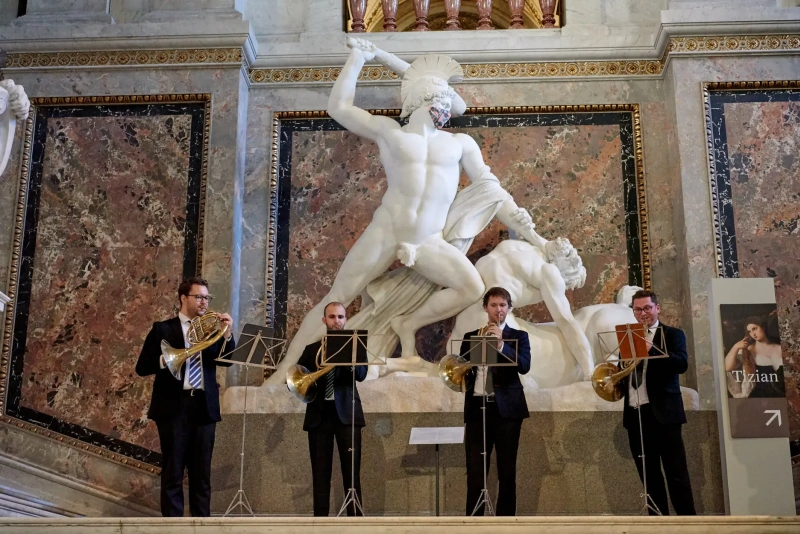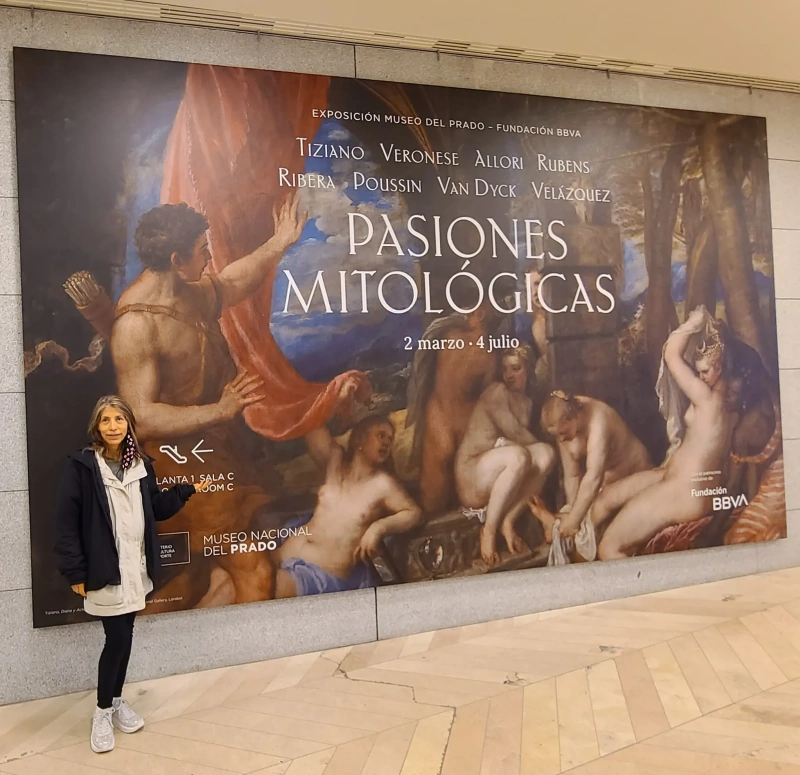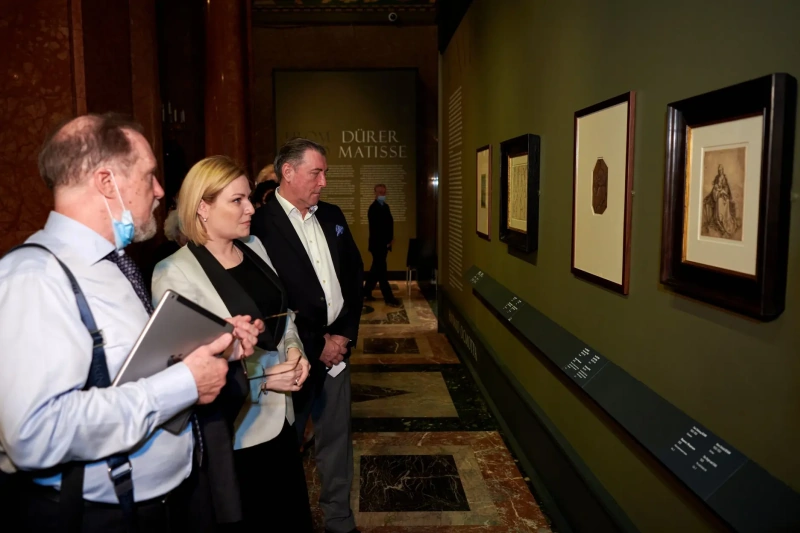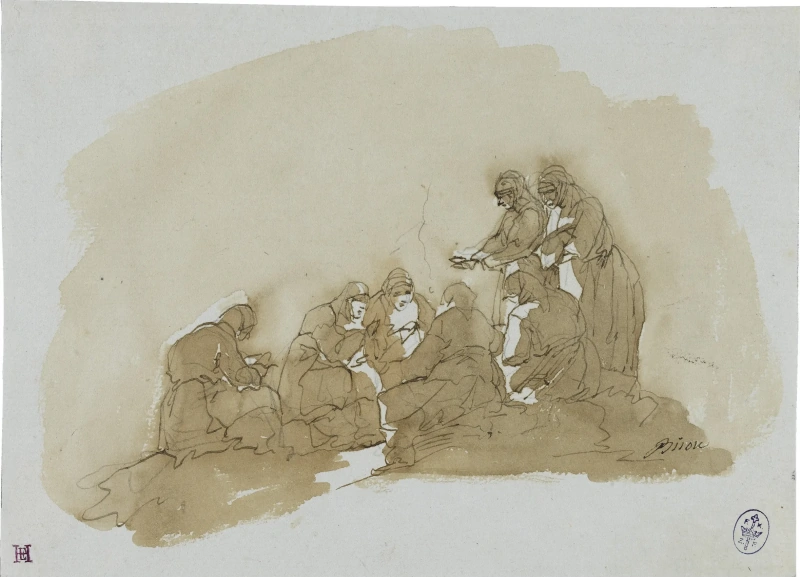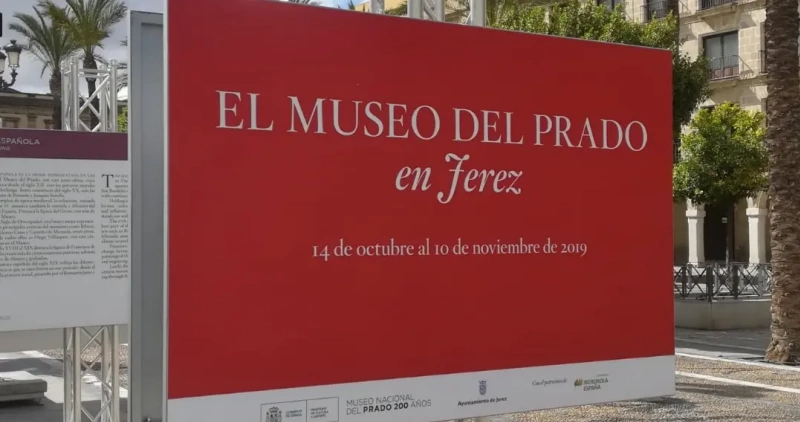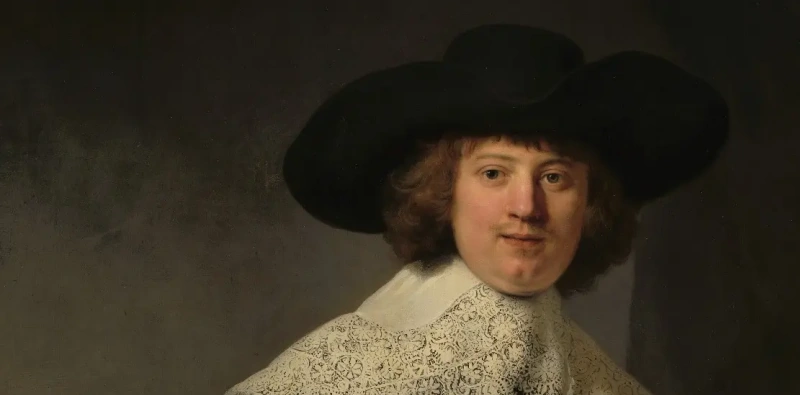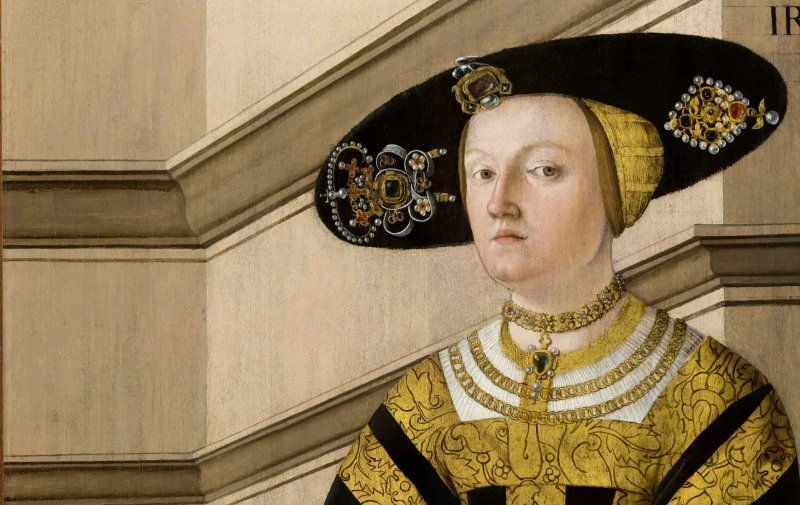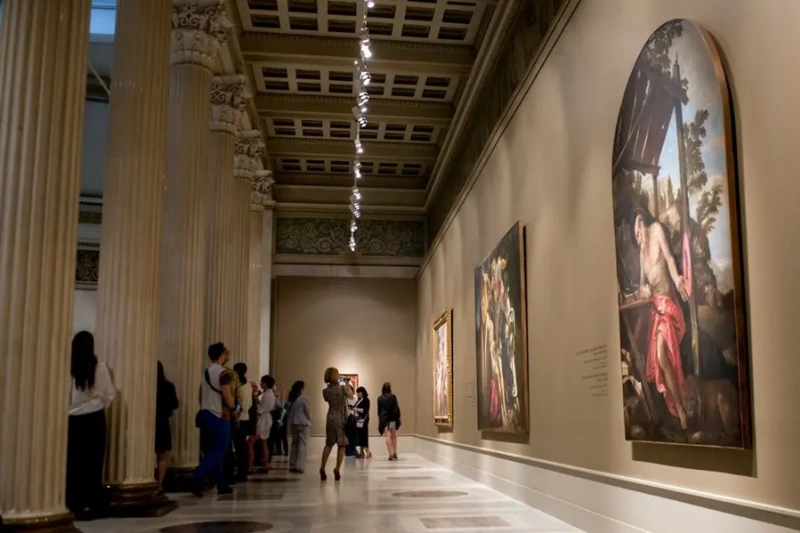log in
Enter site
Login to use Arthive functionality to the maximum
Paolo Veronese, one of the best artists of the Venetian school, was born in Verona in 1528. The real name of the artist was Caliari, and the name of his birthplace was subsequently chosen by the painter as a pseudonym.
Paolo was the fifth of the sons of the sculptor and stonecutter Gabriele Cagliari. To a greater or lesser degree, creativity was inherent in many members of the family: the future artist studied painting with his uncle Antonio Badile. He was not a significant master of his time, but he was able to instill in the boy a love for art and helped him to reveal the artist’s talent. Antonio's daughter, Elena, married Veronese in 1566.
The works in the genres of monumental and decorative painting, in which Paolo worked from his youth until the end of his life, brought him fame at the age of 25. The artist’s works are distinguished by lightness of execution and the color palette typical of the painting school of Verona. Furthermore, it should be noted that the images created by Veronese for his paintings on gospel subjects were bold enough for their time. Because of his free thinking, Paolo even went through the Inquisition court, but was acquitted. He was only obliged to correct several controversial paintings. Paolo's family life went well: he was happily married and surrounded by children. In 1583, tired by the cares and labors, the talented painter acquired an estate in which he planned to spend the rest of his life quietly. However, only a few years later a serious illness brought him to the grave. He died of pneumonia in 1588 in Venice.
Peculiar features of Veronese’s art: the artist’s works successfully combine the best features of of the Verona and Raphael schools of painting. Magnificent color, freedom of ideas and bold embodiment of creative ideas, grace and ease of drawing - all this is characteristic of Paolo's works. It is interesting that Veronese used a peculiar technique in his paintings on Biblical subjects when he placed his subjects in modern interiors, dressed in the costumes of that period. The technical innovation of the painter lied in the fact that Paolo took into account the visual distortion of objects when painting the ceilings. He skillfully applied unexpected angles and spatial contractions in his works aiming at the correct perception of the image by the audience. This technique created the illusion of figures floating in the air: subsequently it was widely used by masters of Baroque painting.
Famous paintings of Paolo Veronese: " Rest on the Flight Into Egypt", "Mars and Venus United by Love", "Feast in the House of Levi" and "The Wedding Feast at Cana". The artist’s works in the Doge's Palace, the church of San Sebastiano and Sansovino’s Library of San Marco made a splash in his time and brought the artist fame in the widest circles.
Religious scandal around Paolo Veronese's painting
The end of the 1560s marked the heyday of the artist's skills. By this time, he had gained fame not only in Venice, but also abroad. Large commissions came in huge numbers. Veronese's creativity as a brilliant decorator reached its heights: he was often invited to decorate palaces and villas. In many ways, his popularity was explained by the fact that Paolo was the first artist who thought about the conformity of his works to the architectural features of the buildings. Working in the mural technique, he placed his paintings in the interior with great taste and knowledge. Thanks to this, painting and architecture perfectly complemented each other and looked like a single whole.
Almost all the paintings by Paolo Veronese, even those on the gospel subjects, had secular nature. The artist’s paintings reflect all the splendor of Venice: the luxury of feasts, dresses, the Venetian addiction to holidays and fun. However, the artist’s sincere sympathy for all this and his cheerful talent almost cost him his life.
A significant part of the commissions used to come to the artist from various religious organizations. He painted the church of St. Sebastian, the monastery of San Giorgio Maggiore. His work adorned the refectory of the convent of Santa Maria dei Servi. In 1573, Veronese received a commission from the Basilica dei Santi Giovanni e Paolo - one of the most famous and largest cathedrals in Venice. Two years earlier, the fire destroyed the Titian’s “Last Supper”. Veronese was commissioned to paint a canvas on the same subject. As a result, Veronese’s free arrangement of history - the images of warriors, children, dwarfs and animals in the picture - angered the church. A few months after handing in the painting to the monks, the painter was summoned to the tribunal, demanding an explanation from the artist. Paolo escaped the trial only thanks to his wit and promise to correct the scandalous work in accordance with the Gospel. However, the canvas was not subject to significant alterations: the artist just changed the name and added some explanatory phrases on the canvas.
Now the picture, which once caused such a serious commotion, is kept in the gallery of the Venice Academy. In the 18th century it was badly damaged during the fire, and was fully restored only in 1827.
Features of the late period of Veronese’s art
In the last years of his life, the artist moved away from creating lush decorative paintings. The elegant paintings showing feasts and the life of wealthy citizens were replaced by the works with restrained mood and even tragic subjects. The change in the artist’s style is partly explained by the tragic events that took place in Venice in the mid-70s: fires and the plague epidemic. In the course of several years, Paolo Veronese lost close people, among whom were Titian, Palladio and Daniele Barbaro. In addition, at the end of the 16th century, art went into decline. Venetian artists resisted the ideas of mannerism for much longer period if compared to the painters of the other art schools, however, the features of the new trend began to appear in their work.
At this period, the artist painted a number of paintings on religious subjects, including “Lamentation over the Dead Christ”, “Crucifixion” and “The Resurrection of Christ”. Numerous works of the period described the life of saints, so they were well received by the church and the painter was given all possible support. The later works of Veronese are marked with melancholy and anxiety, sorrow and disappointment.
However, not all the master’s works created in the 80s are so sad. In 1585, Paolo Veronese created one of his most grandiose and solemn works, «Apotheosis of Venice». The ceiling painting in the Doge's Palace, full of allegories and symbols, amazes the public with its splendor, beauty and cold elevation of the images.
Read more
Paolo was the fifth of the sons of the sculptor and stonecutter Gabriele Cagliari. To a greater or lesser degree, creativity was inherent in many members of the family: the future artist studied painting with his uncle Antonio Badile. He was not a significant master of his time, but he was able to instill in the boy a love for art and helped him to reveal the artist’s talent. Antonio's daughter, Elena, married Veronese in 1566.
The works in the genres of monumental and decorative painting, in which Paolo worked from his youth until the end of his life, brought him fame at the age of 25. The artist’s works are distinguished by lightness of execution and the color palette typical of the painting school of Verona. Furthermore, it should be noted that the images created by Veronese for his paintings on gospel subjects were bold enough for their time. Because of his free thinking, Paolo even went through the Inquisition court, but was acquitted. He was only obliged to correct several controversial paintings. Paolo's family life went well: he was happily married and surrounded by children. In 1583, tired by the cares and labors, the talented painter acquired an estate in which he planned to spend the rest of his life quietly. However, only a few years later a serious illness brought him to the grave. He died of pneumonia in 1588 in Venice.
Peculiar features of Veronese’s art: the artist’s works successfully combine the best features of of the Verona and Raphael schools of painting. Magnificent color, freedom of ideas and bold embodiment of creative ideas, grace and ease of drawing - all this is characteristic of Paolo's works. It is interesting that Veronese used a peculiar technique in his paintings on Biblical subjects when he placed his subjects in modern interiors, dressed in the costumes of that period. The technical innovation of the painter lied in the fact that Paolo took into account the visual distortion of objects when painting the ceilings. He skillfully applied unexpected angles and spatial contractions in his works aiming at the correct perception of the image by the audience. This technique created the illusion of figures floating in the air: subsequently it was widely used by masters of Baroque painting.
Famous paintings of Paolo Veronese: " Rest on the Flight Into Egypt", "Mars and Venus United by Love", "Feast in the House of Levi" and "The Wedding Feast at Cana". The artist’s works in the Doge's Palace, the church of San Sebastiano and Sansovino’s Library of San Marco made a splash in his time and brought the artist fame in the widest circles.
Religious scandal around Paolo Veronese's painting
The end of the 1560s marked the heyday of the artist's skills. By this time, he had gained fame not only in Venice, but also abroad. Large commissions came in huge numbers. Veronese's creativity as a brilliant decorator reached its heights: he was often invited to decorate palaces and villas. In many ways, his popularity was explained by the fact that Paolo was the first artist who thought about the conformity of his works to the architectural features of the buildings. Working in the mural technique, he placed his paintings in the interior with great taste and knowledge. Thanks to this, painting and architecture perfectly complemented each other and looked like a single whole.
Almost all the paintings by Paolo Veronese, even those on the gospel subjects, had secular nature. The artist’s paintings reflect all the splendor of Venice: the luxury of feasts, dresses, the Venetian addiction to holidays and fun. However, the artist’s sincere sympathy for all this and his cheerful talent almost cost him his life.
A significant part of the commissions used to come to the artist from various religious organizations. He painted the church of St. Sebastian, the monastery of San Giorgio Maggiore. His work adorned the refectory of the convent of Santa Maria dei Servi. In 1573, Veronese received a commission from the Basilica dei Santi Giovanni e Paolo - one of the most famous and largest cathedrals in Venice. Two years earlier, the fire destroyed the Titian’s “Last Supper”. Veronese was commissioned to paint a canvas on the same subject. As a result, Veronese’s free arrangement of history - the images of warriors, children, dwarfs and animals in the picture - angered the church. A few months after handing in the painting to the monks, the painter was summoned to the tribunal, demanding an explanation from the artist. Paolo escaped the trial only thanks to his wit and promise to correct the scandalous work in accordance with the Gospel. However, the canvas was not subject to significant alterations: the artist just changed the name and added some explanatory phrases on the canvas.
Now the picture, which once caused such a serious commotion, is kept in the gallery of the Venice Academy. In the 18th century it was badly damaged during the fire, and was fully restored only in 1827.
Features of the late period of Veronese’s art
In the last years of his life, the artist moved away from creating lush decorative paintings. The elegant paintings showing feasts and the life of wealthy citizens were replaced by the works with restrained mood and even tragic subjects. The change in the artist’s style is partly explained by the tragic events that took place in Venice in the mid-70s: fires and the plague epidemic. In the course of several years, Paolo Veronese lost close people, among whom were Titian, Palladio and Daniele Barbaro. In addition, at the end of the 16th century, art went into decline. Venetian artists resisted the ideas of mannerism for much longer period if compared to the painters of the other art schools, however, the features of the new trend began to appear in their work.
At this period, the artist painted a number of paintings on religious subjects, including “Lamentation over the Dead Christ”, “Crucifixion” and “The Resurrection of Christ”. Numerous works of the period described the life of saints, so they were well received by the church and the painter was given all possible support. The later works of Veronese are marked with melancholy and anxiety, sorrow and disappointment.
However, not all the master’s works created in the 80s are so sad. In 1585, Paolo Veronese created one of his most grandiose and solemn works, «Apotheosis of Venice». The ceiling painting in the Doge's Palace, full of allegories and symbols, amazes the public with its splendor, beauty and cold elevation of the images.
-
Artworks liked by111 users
- Artworks in 9 collections and 155 selections
Veröffentlichungen
Ausstellungen
Alle Ausstellungen des Künstlers
Himmelfahrt der Jungfrau Maria
1587, 472×302 cm

Venus und Adonis
1586, 68×52 cm

Herkules, Dejnira und Zentaur Ness
1586, 68.4×53.4 cm

Die Verkündigung
1585, 98.4×75.3 cm
Feed
Titian's vision of a womanexhibition finished

5 Oktober 2021 − 16 Januar 2022 Kunsthistorisches Museum, Vienna, Austria, Maria-Theresien-Platz
Titian's vision of a womanexhibition added

5 Oktober 2021 − 16 Januar 2022 Kunsthistorisches Museum, Vienna, Austria, Maria-Theresien-Platz



